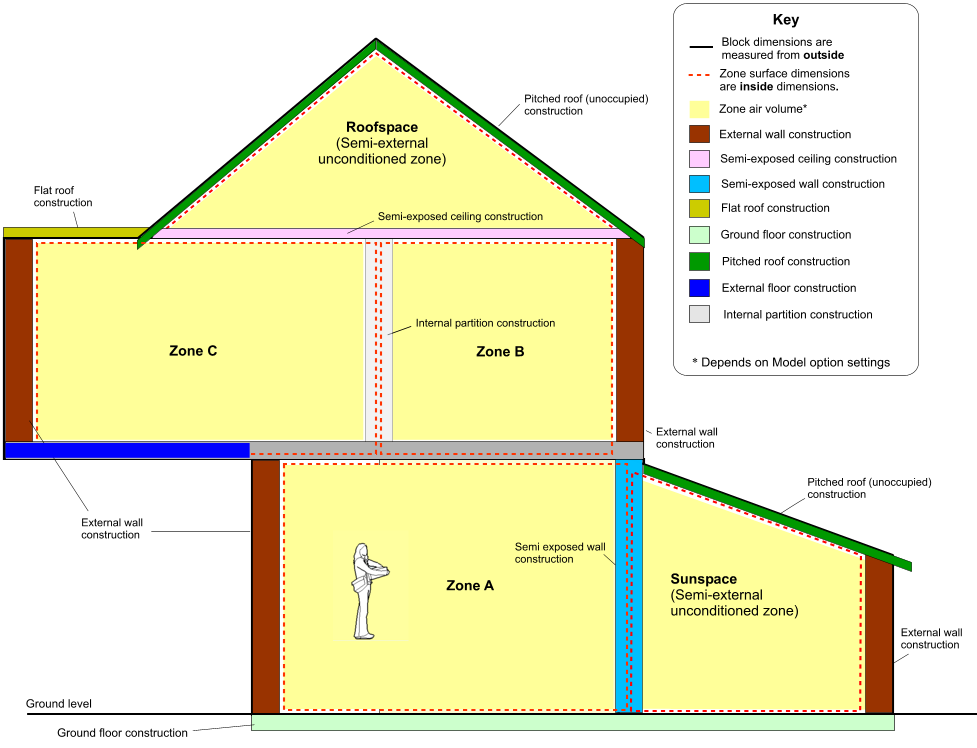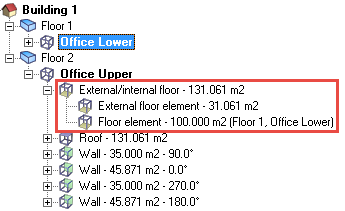
Construction tab in model data under Construction header
When the Floor/slab/ceiling representation model option is set to Combined wall, floor and roof constructions are all defined using simple constructions as shown in the diagram below.
Note that if you are using the NCM for EPCs or Part-L/Section 6 calculations you should refer to the Block and Zone Dimensions page for a more detailed definition of block heights.
The diagram shows:
The schematic below shows the locations of the surface types and the constructions that will be applied to them.

The external wall construction defines the construction of walls adjacent to outside. The definition of walls is given by the roof-wall transition angle model option. In cold climates this construction will generally include an insulating layer.
The Below grade wall construction is used for walls that are adjacent to ground. If there are no below grade (underground) walls in the model then just ignore this data.
Flat roof constructions apply to external horizontal surfaces. The construction used to represent the flat roof should include any slabs, insulation and suspended ceiling layers. If there are no flat roof surfaces, just ignore this data.
The Pitched roof (occupied) construction applies to external sloped surfaces when they appear in occupied zones. In cold climates this construction will generally include an insulating layer. If there are no pitched roof surfaces, just ignore this data.
The definition of 'pitched roof' is given by the roof-wall transition angle model option.
The Pitched roof (unoccupied) construction applies to external sloped surfaces when they appear in Semi exterior unconditioned zones. This construction will generally not include any insulation layers. If there are no pitched roof surfaces, just ignore this data.
The definition of 'pitched roof' is given by the roof-wall transition angle model option.
The internal partition construction defines the construction of internal partitions (walls used to divide blocks into zones) and inter-block partitions (internal walls shared with other blocks). Internal partitions are used where both zones are occupied. When one of the zones is occupied and the other is not the Semi-exposed walls construction data is used (below). If there are no partitions just ignore this data.
The construction for the partition should represent all the layers in the actual internal wall. There is only one element representing the partition between the zones and all it's layers should be defined in the same construction.
Changes in model data settings at the surface level are reflected as equivalent changes in data for the partition on the surface representing other side.
Note: this data is not available at zone level to avoid ambiguity when different settings are made in adjacent zones.
The semi-exposed wall construction applies to walls between fully occupied zones and Semi-exterior unconditioned zones. They will normally include some insulation. DesignBuilder determines which of the zones is relatively 'outside' and uses this information to correctly order the material layers in the wall. The material layer defined in the construction as being 'outermost' (first-in list) will be the one adjacent to the semi-exterior unconditioned zone. If there are no semi-exposed wall surfaces, just ignore this data.
Note: this data is not available at zone level to avoid ambiguity when different settings are made in adjacent zones.
The semi-exposed ceiling construction is used between occupied zones and Semi-exterior unconditioned zones (such as roofspace/attic/loft spaces) above. The construction should include any slabs, insulation and suspended ceiling layers. DesignBuilder determines which of the zones is relatively 'exterior' and uses this information to correctly order the material layers in the roof. If there are no semi-exposed ceiling surfaces, just ignore this data.
Note: the semi-exposed ceiling data is defined from the occupied zone side only. If you navigate to the other side of the surface (the semi-exterior unconditioned zone floor) the data is not available for access.
The semi-exposed floor construction is used between occupied zones and Semi-exterior unconditioned spaces below. The construction should include any slabs, insulation and raised floor layers. If there are no semi-exposed floor surfaces, just ignore this data.
Note: This data is accessed from the occupied zone side only and cannot be accessed from the ceiling surface of the semi-exterior unconditioned zone below.
The ground floor construction is used between all internal zones and the ground. The site ground temperatures are applied to the outside of all surfaces adjacent to ground. If there are no ground floor or wall surfaces, just ignore this data.
Used for ASHRAE 90.1 models only, the Basement ground floor construction is applied to zones with their floors adjacent to the ground when the zone's block has no external perimeter, which normally means that they are basements. The site ground temperatures are applied to the outside of these basement ground floor surfaces. If there are no basement ground floor surfaces in the model, this data can be ignored.
Note: The Basement ground floor is provided to help distinguish floors from slab-on-grade floors. It is normally outside the scope of slab-on-grade floor definition described in ASHRAE 90.1 and is not regulated by the 90.1 Standard. In DesignBuilder the baseline model uses the same construction for Basement ground floor as that used in the proposed model, typically a standard layered floor construction (as opposed to an F-Factor construction normally used for slab on grade floors).
External floors are floors that are adjacent to outside air, e.g. the floor of a cantilevered part of the building or where for any other reason there is no ground or other zone below. The External floor construction should include any slabs, insulation and raised floor layers. If there are no external floor surfaces, just ignore this data.
The internal floor construction defines the makeup of floors between occupied zones including any slabs, air gaps, raised floors and suspended ceilings. It will not usually contain insulation. Where the zone above is unoccupied the semi-exposed ceiling construction is used instead. Likewise where the zone below is unoccupied the Semi-exposed floor construction is used instead. If there are no internal floor surfaces, just ignore this data.
When working with constructions it is often useful to view and make settings at surface level as this is the data that is actually used in calculations. Building, block and zone construction data is used as defaults for surface level data.
On the Navigator panel, for each surface, you will see one or more adjacency items listed below and to the right as shown in the highlighted region of the screenshot below. Clicking on any of the highlighted items in the navigator list will take you to the same surface level.

Important Note: DesignBuilder does not provide direct access to adjacency level data in the editor. For example, in the above screenshot, when navigating to the surface level by clicking on the "External/internal floor - 131.061 m2" item you will be working at the same surface level and with the same data as if you had navigated to one of the adjacency items below, e.g. "External floor element - 31.061 m2". You can set the construction type of both the external and internal floors from the surface level.
The zone volume is calculated for all zone geometries and by default, the volume is the actual air volume of the space excluding the volume of floor and ceiling constructions but including half the volume of partition walls. The volume of the floor constructions can be optionally subtracted from the zone volume by using the Zone volume calculation Model options.